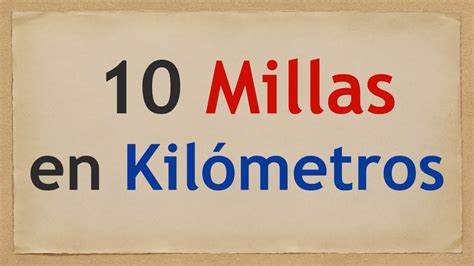Cuanto Es 10 Millas En Kilometros
Kalali
Apr 02, 2025 · 4 min read

Table of Contents
How Many Kilometers are in 10 Miles? A Comprehensive Guide
Knowing how to convert miles to kilometers is a crucial skill, whether you're planning a road trip, interpreting a map, or simply expanding your understanding of the metric system. This comprehensive guide will not only answer the question "cuanto es 10 millas en kilometros?" (how many kilometers are in 10 miles?) but also delve deeper into the conversion process, provide helpful tips, and explore related topics.
Understanding the Conversion Factor: Miles to Kilometers
The fundamental relationship between miles and kilometers rests on a simple conversion factor. One mile is approximately equal to 1.60934 kilometers. This means that to convert miles to kilometers, you simply multiply the number of miles by this factor.
Calculating 10 Miles in Kilometers
Let's address the central question: cuanto es 10 millas en kilometros?
To convert 10 miles to kilometers, we multiply 10 by the conversion factor:
10 miles * 1.60934 kilometers/mile ≈ 16.0934 kilometers
Therefore, 10 miles is approximately equal to 16.09 kilometers. For most practical purposes, rounding to 16.1 kilometers is perfectly acceptable.
Beyond the Calculation: Practical Applications and Context
Understanding the conversion goes beyond a simple mathematical calculation. Consider these practical applications:
-
Travel Planning: Planning a road trip? Knowing the kilometer equivalent of your planned mileage allows you to better estimate travel time, fuel consumption, and overall trip logistics. Especially when navigating areas that primarily use the metric system, this conversion is essential.
-
Mapping and Navigation: Many maps and navigation systems offer the option to switch between miles and kilometers. Familiarizing yourself with both units helps you easily understand distances regardless of the map's default setting.
-
Fitness and Exercise: Whether you're tracking your running, cycling, or walking distances, converting between miles and kilometers ensures consistency in your fitness records and allows comparison with data using either unit of measurement.
-
International Trade and Commerce: Global commerce often involves dealing with both imperial and metric units. Understanding conversions ensures accurate measurements in shipping, manufacturing, and other international business activities.
Methods for Conversion: Manual Calculation vs. Online Tools
While manual calculation using the conversion factor is straightforward, several other methods simplify the process:
-
Manual Calculation (as shown above): This method provides a clear understanding of the underlying principle of conversion.
-
Online Conversion Tools: Numerous websites and apps offer instant mile-to-kilometer conversions. These tools are particularly helpful for quick calculations and multiple conversions. Simply input the number of miles, and the tool provides the equivalent in kilometers.
-
Conversion Calculators on Smartphones and Tablets: Many smartphones and tablets come pre-installed with calculators that include conversion functionalities, allowing you to perform the conversion directly on your device.
Expanding Your Knowledge: Other Relevant Conversions
Understanding miles-to-kilometers conversion often leads to exploring related units and conversions:
-
Kilometers to Miles: The reverse conversion is equally important. To convert kilometers to miles, divide the number of kilometers by the conversion factor (approximately 1.60934).
-
Miles to Meters: Since 1 kilometer equals 1000 meters, you can convert miles to meters by first converting to kilometers and then multiplying by 1000.
-
Kilometers to Yards/Feet/Inches: Similar to the above, you can use a series of conversions to move between different units of distance.
Addressing Potential Errors and Inconsistencies
When dealing with conversions, it's crucial to be aware of potential sources of error:
-
Rounding Errors: Rounding off the conversion factor can introduce minor inaccuracies, particularly when dealing with large distances. Using the full conversion factor (1.60934) minimizes these errors.
-
Inconsistent Units: Ensure consistency in units throughout your calculations. Mixing miles and kilometers (or other units) within the same calculation will lead to incorrect results.
-
Using the Wrong Conversion Factor: Double-check that you're using the correct conversion factor (1.60934 kilometers per mile) for accurate results.
Practical Tips for Accurate Conversion
-
Use a calculator: For precise conversions, especially for longer distances, a calculator is highly recommended.
-
Understand significant figures: Pay attention to the number of significant figures in your measurements. The result of your conversion should not have more significant figures than the least precise measurement used in the calculation.
-
Double-check your work: Always verify your results using a second method, such as an online converter or by performing the calculation again.
Beyond the Basics: Historical Context and the Significance of Units
The choice between miles and kilometers often reflects different systems of measurement and their historical development. Miles are associated with the imperial system, while kilometers are part of the metric system. Understanding the historical context behind these units adds depth to our understanding of distance measurement.
Conclusion: Mastering the Mile-to-Kilometer Conversion
Mastering the conversion between miles and kilometers empowers you to navigate the world more effectively. Whether planning a trip, interpreting maps, or engaging in any activity involving distance measurement, the ability to readily convert between these units is invaluable. This guide has provided a comprehensive understanding of the conversion process, practical applications, and potential pitfalls. By following the tips and strategies outlined here, you can confidently and accurately convert between miles and kilometers in any situation. Remember, the conversion factor – approximately 1.60934 kilometers per mile – is your key to accurate and efficient distance conversions.
Latest Posts
Latest Posts
-
How Does Erosion Change The Surface Of The Earth
Apr 03, 2025
-
What Type Of Symmetry Do Mollusks Have
Apr 03, 2025
-
Least Common Factor Of 8 And 9
Apr 03, 2025
-
What Percent Of 16 Is 3
Apr 03, 2025
-
How Does Pulmonary Circulation Differ From Coronary Circulation
Apr 03, 2025
Related Post
Thank you for visiting our website which covers about Cuanto Es 10 Millas En Kilometros . We hope the information provided has been useful to you. Feel free to contact us if you have any questions or need further assistance. See you next time and don't miss to bookmark.
